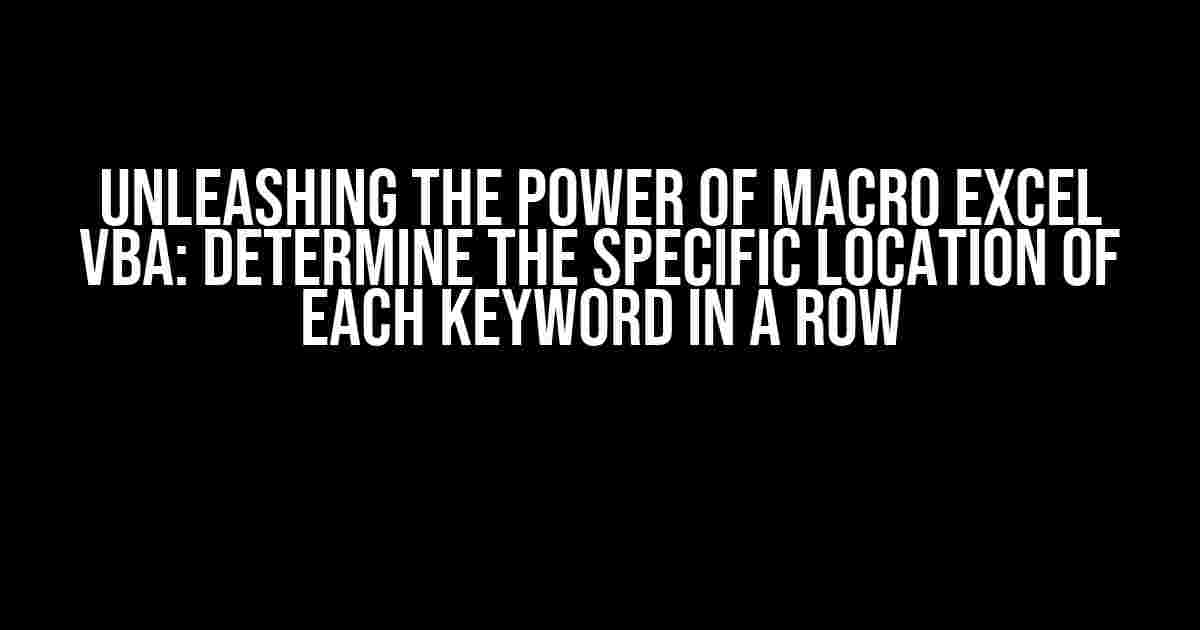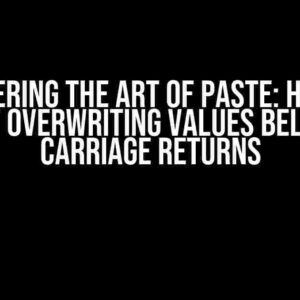Are you tired of manually searching for specific keywords in your Excel spreadsheets? Do you want to automate the process and get instant results? Look no further! In this comprehensive guide, we’ll show you how to harness the power of Macro Excel VBA to determine the specific location of each keyword in a row. Get ready to revolutionize your workflow and take your Excel skills to the next level!
What You’ll Need
- Microsoft Excel (2010 or later)
- Basic understanding of VBA (Visual Basic for Applications)
- A spreadsheet with data containing keywords you want to search for
The Problem: Manual Keyword Search
Imagine you have a massive spreadsheet with hundreds of rows and columns, and you need to find the specific location of each keyword in a row. Sounds like a daunting task, right? With traditional methods, you’d have to:
- Manually scroll through each row
- Read through the contents of each cell
- Identify the keyword and note down the row and column numbers
This process is not only time-consuming but also prone to errors. That’s where Macro Excel VBA comes to the rescue!
The Solution: Macro Excel VBA
With Macro Excel VBA, you can create a custom script that searches for specific keywords in a row and returns their exact location. Here’s the magic code to get you started:
Sub FindKeywords()
Dim ws As Worksheet
Dim lastRow As Long
Dim i As Long
Dim keyword As String
Dim foundCell As Range
Set ws = ThisWorkbook.ActiveSheet
lastRow = ws.Cells(ws.Rows.Count, "A").End(xlUp).Row
' Set the keyword you want to search for
keyword = "YOUR_KEYWORD_HERE"
For i = 1 To lastRow
For Each cell In ws.Range(ws.Cells(i, 1), ws.Cells(i, ws.Columns.Count)).Cells
If InStr(1, cell.Value, keyword) > 0 Then
Set foundCell = cell
MsgBox "Keyword found in cell " & foundCell.Address & " in row " & i
End If
Next cell
Next i
End Sub
In this code, we:
- Set the active worksheet and determine the last row with data
- Define the keyword to search for (replace “YOUR_KEYWORD_HERE” with your desired keyword)
- Loop through each row and cell, checking if the keyword is present
- Display a message box with the cell address and row number when the keyword is found
Customizing the Code: Advanced Techniques
Now that you have the basic code up and running, let’s take it to the next level with some advanced techniques:
1. Search for Multiple Keywords
Dim keywords As Variant
keywords = Array("Keyword1", "Keyword2", "Keyword3")
For Each key In keywords
For i = 1 To lastRow
For Each cell In ws.Range(ws.Cells(i, 1), ws.Cells(i, ws.Columns.Count)).Cells
If InStr(1, cell.Value, key) > 0 Then
Set foundCell = cell
MsgBox "Keyword '" & key & "' found in cell " & foundCell.Address & " in row " & i
End If
Next cell
Next i
Next key
In this example, we define an array of keywords and loop through each one, searching for its occurrence in the spreadsheet.
2. Search within Specific Columns
For i = 1 To lastRow
For Each cell In ws.Range(ws.Cells(i, 2), ws.Cells(i, 5)).Cells
If InStr(1, cell.Value, keyword) > 0 Then
Set foundCell = cell
MsgBox "Keyword found in cell " & foundCell.Address & " in row " & i
End If
Next cell
Next i
Here, we restrict the search to columns 2 to 5 (B to E) by adjusting the range in the inner loop.
3. Return Results to a Separate Worksheet
Dim resultsWs As Worksheet
Set resultsWs = ThisWorkbook.Worksheets.Add
For i = 1 To lastRow
For Each cell In ws.Range(ws.Cells(i, 1), ws.Cells(i, ws.Columns.Count)).Cells
If InStr(1, cell.Value, keyword) > 0 Then
foundRow = i
resultsWs.Cells(resultsWs.Rows.Count, "A").End(xlUp).Offset(1, 0).Value = "Keyword found in cell " & cell.Address & " in row " & foundRow
End If
Next cell
Next i
In this example, we create a new worksheet to store the search results, and use the `Offset` method to append each result to the next available row.
Conclusion
With Macro Excel VBA, you’ve unleashed the power to determine the specific location of each keyword in a row. No more manual searching, no more errors! By customizing the code with advanced techniques, you can tailor the script to your specific needs and take your Excel workflow to new heights.
Remember to adjust the code to fit your unique requirements, and don’t hesitate to explore the vast possibilities of Macro Excel VBA. Happy coding!
| Keyword | Row Number | Cell Address |
|---|---|---|
| Keyword1 | 5 | $B$5 |
| Keyword2 | 10 | $D$10 |
| Keyword3 | 15 | $E$15 |
This table demonstrates the output of the script, showing the keyword, row number, and cell address for each result.
Frequently Asked Questions
Get ready to unlock the secrets of Macro Excel VBA and discover how to pinpoint the exact location of each keyword in a row!
Q: What is the purpose of using Macro Excel VBA to find specific keywords in a row?
The purpose of using Macro Excel VBA is to automate the process of searching for specific keywords in a row, saving time and increasing efficiency. This is particularly useful when working with large datasets or repetitive tasks.
Q: How does Macro Excel VBA determine the specific location of each keyword in a row?
Macro Excel VBA uses a combination of code and algorithms to search for specific keywords in a row. The code can be customized to search for exact phrases, words, or characters, and can return the column and row number of the found keyword.
Q: What are some common applications of using Macro Excel VBA to find specific keywords in a row?
Some common applications include data analysis, content filtering, text mining, and automation of tasks. For example, a marketing team can use Macro Excel VBA to search for specific keywords in customer feedback to identify trends and insights.
Q: Can Macro Excel VBA be used to search for multiple keywords in a row?
Yes, Macro Excel VBA can be used to search for multiple keywords in a row. The code can be modified to search for an array of keywords, and return the locations of each keyword found.
Q: Is it necessary to have advanced VBA programming skills to use Macro Excel VBA for keyword search?
No, it’s not necessary to have advanced VBA programming skills to use Macro Excel VBA for keyword search. With some basic knowledge of VBA and Excel, you can create a macro to search for specific keywords in a row. You can also find pre-built codes and tutorials online to help you get started.


